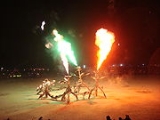
Flaming Lotus Girls
Encyclopedia
The San Francisco, California
San Francisco, California
San Francisco , officially the City and County of San Francisco, is the financial, cultural, and transportation center of the San Francisco Bay Area, a region of 7.15 million people which includes San Jose and Oakland...
,-based Flaming Lotus Girls is a collaborative art group that creates large-scale fire art. The group was founded in 2000 by a group of artists working on a sculpture for the Burning Man
Burning Man
Burning Man is a week-long annual event held in the Black Rock Desert in northern Nevada, in the United States. The event starts on the Monday before the American Labor Day holiday, and ends on the holiday itself. It takes its name from the ritual burning of a large wooden effigy on Saturday evening...
arts festival in the Black Rock Desert
Black Rock Desert
The Black Rock Desert is an arid region in the northern Nevada section of the Great Basin with a lakebed that is a dry remnant of Pleistocene Lake Lahontan...
in Nevada. They take their name from their first sculpture, Flaming Lotus Sr. Their work is notable for being interactive and kinetic. Their pieces are composed primarily of steel, stainless steel, copper, glass, wood, and light, with flames ranging from a 2 inches (50.8 mm) flicker to a 150 feet (45.7 m) blaze.
One distinctive element is that this is a female driven group. A core mission of the group is to help women learn how to use their hands and tools to build sculpture. While they invite both women and men, from expert to novice, to collaborate, all must consider themselves "girls".
Any member who regularly attends meetings can have input in designing, building, operating and playing with the large-scale work that is created. This type of leadership has been coined a do-ocracy. In short, if one wants to see something happen, they take the initiative to do it.
Soma (2009)
Soma translates the anatomy of neurons into metal, fire and light; magnifying the microscopic world to an epic scale. In Soma, an elegant axon arch connects an earthbound neuron with its partner floating overhead. Fire and light flow like electrochemical signals between Soma’s two neurons. Spinning balls of fire form the neuron’s nuclei. Slender dendrites extend to the sky and reach down to the earth, emitting constant flame and color changing light. Computer-controlled flame and sequenced LEDS travel in patterns along the raised Soma archway, creating a spectacular, unique show. Throughout the sculpture, fire and LED lighting accentuate not only the curves and geometric forms of the sculpture, but also the very concept of neuronal transmission of information.All of the fire effects on Soma are participant controlled, allowing the public to communicate with the sculpture itself. Soma offers participants an interactive installation that investigates the very basis of intellectual communication. It invites them to be an active force in this communication, providing input via the controls, sharing their knowledge and creating messages of warmth. A Soma is a cell body of a neuron with branching dendrites (signal receivers) and a projection called an axon, which conducts the nerve signal. At the other end of the axon, the axon terminals transmit electro-chemical signals across a synapse (the gap between the axon terminal and the receiving cell). Soma is an interactive sculptural installation depicting two communicating neurons made of stainless steel, copper, aluminum, bronze, resin, fire and light. Each of Soma’s two neurons has a spinning fire nucleus. The nuclei are counter spinning balls of flame with variable speed motors.
Soma is 25 feet (7.6 m) high and 50 feet (15.2 m) long. It is roughly a rectangular shape that occupies approximately 5000 square feet (464.5 m²), including the fuel depot. She uses up to 100 gallons of fuel per hour. There are 35 Dendrites using approximately 21 feet (6.4 m) of stainless steel tubing each. 735 feet (224 m) of stainless steel tubing was used for dendrites over all. Two dodecahedrons constructed from 24 stainless steel pentagons comprise the cell bodies of Soma, and enclose the nuclei. Each pentagon used about 10 feet (3 m) of stainless steel tubing. A total 240 feet (73.2 m) of stainless steel tubing was used for the dodecahedrons. There are flame effects running down the axon which simulate signal neurotransmission. Participants control the “neurotransmission” by pushing buttons. A “Sparkle Poof” simulates release of neurotransmitters at the synapse. Each aerial dendrite and the axon burn with continuous flame effects. Soma has more than 60 custom LED packages, each housed in a unique casting constructed of resin and aluminum that can each output 270 lumens of light, each individually controllable and capable of 16 million colors.
Mutopia (2008)

During the day, the outgrowths and overhangs of Mutopia provide a still oasis, awaiting the dusk to open its blooms. As the day progresses and wind blows across the playa, something flashes in the sunlight amid the dust, drawing wanderers towards Mutopia. As they approach, they can hear sounds fluttering at the roots and swirling overhead under reflective leaves, beckoning them to come nearer. Mutopia rewards their curiosity with a reaction to their presence. Trying to communicate, the organic lifeforms reflect the participants’ voices back to them and illuminate visual messages on integrated screens. Further in the inner sanctum of the installation, citizens can manipulate the form of Mutopia by turning cranks and pulling levers.
At night Mutopia comes alive – illuminated with light and fire that beckon visitors to enter. The newest Pods are rumbling, hissing steam and glowing with an inner light which occurs with greater or lesser intensity according to human proximity. These Seedpods, aware of their environment and of human presence, respond with a flicker of video and visuals emanating from fruits that emerge from the cast aluminum Seedpods. Moving along the spiral arm, the Pods are extending roots, cracking open, exposing the beginnings of growth and a fire’s glow. A delicate ambient flame quickly develops into propane-driven pneumatics, bursting with fire and movement. Moving on, growth is exponential, roots are solidified and the reproductive parts gain form and move with the force of participant-controlled multi-directional propane “poofers”. Towards the inner vortex, the plants extend tendrils that intertwine, creating archways for participants to gaze through and walk beneath. Humans activate these Pods by using hand cranks and levers to articulate motion and their voices to direct the fire effects. In the inner sanctum of the spiral, the leaves have interwoven to form a canopy of multicolored computer-controlled fire.
In its final stages of growth, Mutopia’s flowers bloom with a show of multi-colored, multi-directional computer-controlled, liquid-fueled fire. At the zenith of maturity, Mutopia majestically projects its seeds and pollen into the environment with a dramatic final blast from the inner sanctum. Completing the cycle, the new seeds of Mutopia start a purposeful journey to new environments where they will lie dormant until watered and cultivated by the creative juices of a new society. Portions of the incomplete sculpture were presented at Maker Faire
Maker Faire
Maker Faire is an event created by Make magazine to "celebrate arts, crafts, engineering, science projects and the Do-It-Yourself mindset".-Past events:The first was held April 22 – 23, 2006, at the San Mateo Fairgrounds...
2008 and Yuri's Night at NASA Ames.
The Serpent Mother (2006)
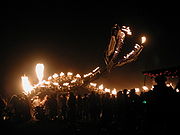
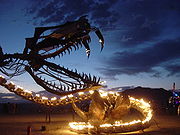
Over a hundred people at a time can stand inside the area enclosed by her curving body, being kept warm and entertained by the fires burning around them.
The completed work has been displayed at
- Robodock Arts and Technology Festival, Amsterdam, Netherlands, September 2007
- The Crucible (arts education center)The Crucible (arts education center)The Crucible is a nonprofit industrial arts school in Oakland, California. Established in Berkeley in 1999, the institute was moved to its present location in 2003.The mission of The Crucible is to foster a collaboration of Arts, Industry and Community...
Fire Arts FestivalFire Arts FestivalEach July The Crucible arts education center in Oakland, California holds the Fire Arts Festival, which celebrates creativity through fire and light with a spectacular open-air exhibition of interactive fire art, performance and the largest collection of outdoor fire sculpture on the West Coast...
, Oakland CA, July 2007 - Burning ManBurning ManBurning Man is a week-long annual event held in the Black Rock Desert in northern Nevada, in the United States. The event starts on the Monday before the American Labor Day holiday, and ends on the holiday itself. It takes its name from the ritual burning of a large wooden effigy on Saturday evening...
arts festival, Nevada, August 2006 - A partially completed version of the sculpture was displayed at The Crucible Fire Arts Festival, July 2006
The Angel of the Apocalypse (2005)
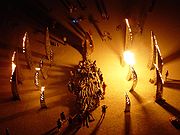
The Angel's wings burn continuously with ambient flame, each feather brought to life with blazing “poof” fire effects controlled by participants gathered in the courtyard of the 50 by 50 feet (15.2 m) installation. Its great head, formed of curved steel plate and enlivened with hand-blown glass eyes, stands 20 feet (6.1 m) tall and functions as a wood burning fireplace.
Visitors are invited to move around and between the Angel’s flaming feathers and to seat themselves atop its driftwood torso. All are encouraged to operate the propane flame effects of its inner wings.
The Seven Sisters (2004)
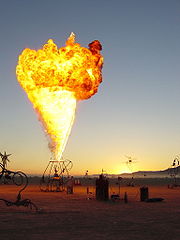
Pleiades (star cluster)
In astronomy, the Pleiades, or Seven Sisters , is an open star cluster containing middle-aged hot B-type stars located in the constellation of Taurus. It is among the nearest star clusters to Earth and is the cluster most obvious to the naked eye in the night sky...
constellation.
- Alcyone
- Celano
- Maia
- Taygeta
- Asterope
- Merope
- Electra
The Hand of God (2003)
A 12 feet (3.7 m) copper sculpture of a woman's hand that shoots flame from all five digits.Fire Garden (2001)
A garden of fire, including copper flowers, a lily pond, and a weeping willow.External links
- Official Flaming Lotus Girls Web site
- Flaming Lotus Girls blog
- Mutopia website
- Serpent Mother website
- Dust & Illusions tells 30 years of History of Burning Man and features the Flaming Lotus Girls
- Videos about the Flaming Lotus Girls from Madnomad Films.
- Flaming Lotus Girls Photo Pool on Flickr
- Definition of Do-ocracy
- http://blog.makezine.com/archive/2009/01/make_television_episode_4_fire_scul.html

